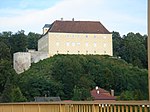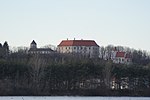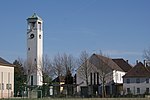List of districts of St. Pölten
St. Pölten is the capital of the largest Austrian state of Lower Austria . The urban area of St. Pölten is divided into eleven districts which, unlike Graz or Vienna, are not numbered. The Traisen runs right through the city from north to south , and is often also the district boundary.
Until 1922, when the first localities were incorporated with Oberwagram, Spratzern, Teufelhof, Unterwagram and Viehofen, the urban area consisted of today's cadastral community of St. Pölten.
After Austria was annexed to the German Reich, a further 19 cadastral communities were incorporated. Of these, only Harland, Oberradlberg, Stattersdorf, Unterradlberg and Völtendorf remained with the city after 1955.
After the transfer of 0.67 km² from Harland to Pyhra in 1957, Ragelsdorf, Waitzendorf, Weitern and Witzendorf were incorporated in 1969.
The largest number of incorporations took place at the turn of the year 1971/72. Partly against great resistance from the population, 37 localities were added to the urban area. These included the then independent communities of Gerersdorf, Pottenbrunn, Ratzersdorf and St. Georgen am Steinfelde. In 1982, nine cadastral communities were reunified and the community of Gerersdorf rebuilt.
The largest district in terms of area, inhabitants and population density is St. Pölten, the smallest according to the same parameters is Ochsenburg. The smallest cadastral municipality in terms of population and population density is Reitzersdorf, after the area Wetzersdorf.
Legend
- Name: Name of the district highlighted in bold, including the cadastral communities. In the case of districts with only one cadastral municipality, this is not listed separately. Deviating spellings of the place names are marked with A.
- EW Total population of the district highlighted in bold, including the population of the localities as of December 31, 2015.
- Fl .: total area of the district in square kilometers (km²) highlighted in bold, including areas of the cadastral communities
- BD: Total population density of the district in inhabitants per square kilometer (1 / km²) highlighted in bold, including population densities of the localities
- Incorporated: year of incorporation. The column is sorted according to the incorporation of the most populous locality, which is highlighted in bold.
- Location: Map of the location of the district in the urban area
- ZIP: ZIP code of the district. The most common zip code comes first.
- Comment: Additional information about the district
- Image: A picture from the district
Overview
| Surname | EW | Fl. | BD | Some | location | Postcode | comment | image |
|---|---|---|---|---|---|---|---|---|
|
Harland Altmannsdorf Harland Windpassing |
1,796 119 1,616 61 |
4.75 1.33 2.01 1.41 |
378 89 804 43 |
(1939-55) 1971 1939 (1939-55) 1971 |

|
3104 3100 | Former industrial center in the southeast of the city. Mostly residential district after the Harlander Coats closed . The cadastral communities have grown together. |

|
|
Ochsenburg Dörfl near Ochsenburg A Ochsenburg |
354 17 337 |
3.72 0.68 3.04 |
95 25 111 |
1971 1971 |

|
3151 | Formerly a rural district in the southeast of the city. Around 1900 strong population increase due to a branch of the Harlander Coats . Ochsenburg Castle stands above the district . Dörfl essentially consists of a residential street behind the castle. |

|
|
Pottenbrunn Pengersdorf Pottenbrunn Wasserburg Zwerndorf |
2,493 57 2,318 61 57 |
17.94 2.45 8.28 6.21 1.00 |
139 23 280 10 57 |
1971 1971 1971 1971 |

|
3140 3100 | Until 1971 independent municipality in the north of the city. The most striking buildings are Pottenbrunn Palace and Wasserburg Palace . While Pengersdorf, Wasserburg and Zwerndorf are independent villages, Pottenbrunn is only separated from Ratzersdorf by the S 33 . |

|
|
Radlberg Oberradlberg Unterradlberg |
1,223 392 831 |
5.28 2.13 3.15 |
232 184 264 |
1939 1939 |

|
3105 | Formerly a rural district in the northwest of the city. Large industrial area on the S 33 with a plant belonging to the Egger Group , where, in addition to wood products, "Radlberger" drinks and "Egger beer" are produced. Radlberg is separated from the rest of the city by a mountain and the Traisen . |

|
| Ratzersdorf | 1,514 | 5.58 | 271 | (1939-55) 1971 |

|
3100 | Formerly a rural district in the northeast of the city. Today, among other things through targeted promotion of the city, popular residential district. In the area of the St. Pölten-Nord junction of the S 33, there is an extensive industrial area. Ratzersdorf has de facto merged with Pottenbrunn in the north and with Wagram in the south. |

|
|
Spratzern Matzersdorf Pummersdorf Schwadorf Spratzern Völtendorf |
6,540 28 98 31 6,257 126 |
14.43 1.15 3.23 1.11 6.94 2.00 |
453 24 30 28 902 63 |
1971 (1939-55) 1971 (1939-55) 1971 1922 1939 |

|
3106 3385 3100 | In addition to large housing estates, the district in the south-west is home to some of the city's largest businesses, especially due to the good connection to the A1 that runs right through the district . The headquarters of Kika and Leiner are located here. The private university of the creative industries also finds its place here. While Matzersdorf, Pummersdorf, Schwadorf and Völtendorf are independent villages, Spratzern has grown together with St. Pölten. |

|
|
St. Georgen am Steinfelde Eggendorf Ganzendorf Hart Kreisberg Mühlgang Reitzersdorf St. Georgen am Steinfelde A Steinfeld Wetzersdorf Wolfenberg Wörth |
3,458 1,199 82 1,085 26 525 4 335 114 10 16 62 |
12.42 1.02 0.78 3.12 0.91 0.96 0.91 0.67 1.72 0.55 0.74 1.04 |
278 1,175 105 348 29 547 4 500 66 18 22 60 |
1971 1971 (1939-55) 1971 1971 1971 1971 1971 1971 1971 (1939-55) 1971 (1939-55) 1971 |

|
3151 3100 | Independent municipality in the south of the city until 1971. Here are the works next to housing estates Wörth, one of the largest turnouts producers in the country. Many of the cadastral communities are hamlets with often only a few houses, the villages of Eggendorf, Hart, Mühlgang, St. Georgen and Wörth have grown together to form a common settlement area with Spratzern. |

|
|
St. Pölten Hafing Nadelbach St. Pölten A Teufelhof Waitzendorf Witzendorf |
22,414 36 83 21,324 551 341 79 |
20.95 1.53 1.64 11.79 0.84 3.43 1.72 |
1,070 24 51 1,809 656 99 46 |
1971 1971 - 1922 1969 1969 |

|
3100 3104 3107 3151 (3109) | Core district that extends to the west. Here you will find the historic old town with authorities, museums and the seat of the Bishop of St. Pölten . In the district are the University Medical Center St. Pölten , the HTBLuVA St. Pölten and the Fachhochschule St. Pölten home. In addition to the Landhausviertel as the seat of the Lower Austrian provincial government , the district houses most of the city's residents. With Voith and the recently closed Glanzstoff Austria, there is also large industry here. The places Hafing, Nadelbach and Witzendorf are independent villages. |

|
| Stattersdorf | 1,973 | 4.92 | 401 | 1939 |

|
3100 3104 | With the Salzer paper mill and a branch of the Harlander Coats, a former industrial village in the east of the city. Today most of all place of residence. In the north, Stattersdorf is fused with Wagram and only separated from St. Pölten and Spratzern by the Traisen . |

|
|
Viehofen Ragelsdorf Viehofen Further |
5,421 522 4,677 222 |
8.12 3.70 2.58 1.84 |
668 141 1,813 121 |
1969 1922 1969 |

|
3107 3100 | Former industrial village in the northwest of the city. In addition to residential areas, it is also home to an industrial area with the Traisenpark in the center and the Viehofner Lakes, an important local recreation area in the city. Ragelsdorf and Weitern are independent villages, Viehofen has merged with St. Pölten. |

|
|
Wagram Oberwagram Upper ground Brunn A sub-Wagram Lower ground Brunn A |
6,433 4,143 71 2,177 42 |
10.41 3.46 2.06 2.43 2.46 |
618 1,197 34 896 17 |
1922 (1939-55) 1971 1922 (1939-55) 1971 |

|
3108 3100 | Popular residential district in the east of the city. The city's largest cinema and the Lower Austrian State Sports School are located here . Ober- and Unter Zwischenbrunn are independent villages, Ober- and Unterwagram, on the other hand, are only removed from the urban area by the Traisen. |

|
| City of St. Pölten | 53,619 | 108.52 | 494 | |||||
Individual evidence
- KG Dörfl near Ochsenburg: Dörfl
- KG St. Georgen am Steinfelde: Sankt Georgen am Steinfelde
- KG St. Pölten: Sankt Pölten
-
^ Kurt Klein (edit.): Historical local dictionary . Statistical documentation on population and settlement history. Ed .: Vienna Institute of Demography [VID] d. Austrian Academy of Sciences . Lower Austria part 1, St. Pölten (city) - districts , p. 10 ( online document , explanations . Suppl . ; both PDF - oD [updated]). Special references: St. Pölten. Annual statistical report 2006
- ↑ a b Magistrate of the City of St. Pölten: Annual Statistical Report 2015.
- ↑ Historical urban development
- ↑ Locations with postcodes on statistik.at , created on January 12, 2017
- ↑ The Lower Austrian state government has its own postcode
